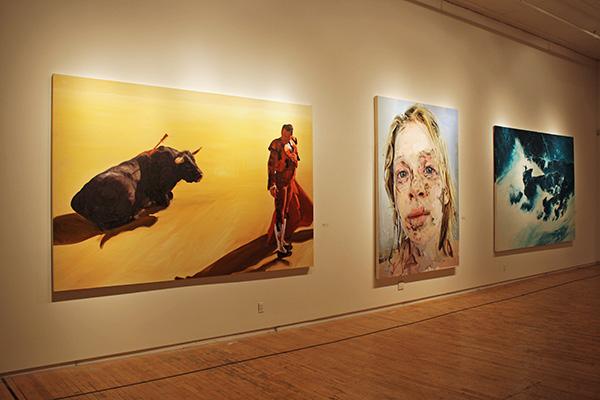NEW YORK—Elizabeth Hobson said she’s never seen people so absorbed in the works at an opening of a show. But Big Picture had them mesmerized when it opened at New York Academy of Art on Jan. 28.
The reaction was no surprise considering exhibition participants—Vincent Desiderio, Eric Fischl, Neo Rauch, Jenny Saville, and Mark Tansey—loom large in the eyes of their mentees at the academy.
Hobson, the Director of Exhibitions for the New York Academy of Art, organized the small show of large paintings—a celebration of the academy’s community of critics and mentors. Big Picture, curated by Peter Drake, Dean of Academic Affairs, features only seven works if you count Vincent Desiderio’s wall-blanketing triptych as one painting.
For the Academy community though, Big Picture is a big deal. It’s the first time the Academy has centered a show on the size and scale of paintings. It’s also the first ever exhibit at the Academy that shines the light on non-Academy graduates.
Naturally, Academy students cherish an opportunity to study and dissect the works of their idols.
These artists are as different as their pictures are commanding.
Of the paintings in this show, “Coastline Measure,” 1987 by Mark Tansey, is possibly the most immediate descendant of grand landscapes like Albert Bierstadts’. In it, a team of surveyors attempt to catalog the contours of the seashore as water crashes and swirls around them. A looming sense of nature’s wrath contrasts with the audacity of human ambition.
Tansey works nearly exclusively in monochrome with an almost mathematical approach to composition and detail. This is most evident in “Duet,” 2004, a painting resulting from a collage of images that depicts two rock climbers scaling endless crags of blue.
Viewing it, I was confused why this seemingly straightforward scene confused me. The answer comes from careful study of the figures—there are two light sources: one from above and one from the side. Studying it is much like picking out faces from the textures of a stucco ceiling (a childhood pastime)—suggestions of figures appear among the shadows and the paint smears, and then disappear.
Vincent Desiderio’s enigmatically titled ”Quixote,” is a commentary on the progression of art from classical (represented by the first painting, of a wrapped piano cover, weightlessly suspended against the sky) to contemporary (represented by a hoofed animal skinned, gutted, and stretched out on some metal contraption). The center panel, the largest canvas in the show, is occupied by a shadow of a bike wheel, whose elliptical shape calls to mind the orbit of a planet or the cyclical nature of history.
The girl in “Bleach” by Jenny Saville stares out at the gallery with her big, clear eyes—the only part of the towering picture that isn’t composed of swirls of thick impasto. Her face seems initially a patchwork of colors until you step back and realize that she’s battered, crusted with blood. There’s nothing in her expression that betrays any pain. Does the title refer to her blonde hair? Or to the weapon used against her?
There’s so much artistic intent behind each painting that one can only wonder at. Little help comes from the labels, which merely name and date the artworks. But snatch a well-versed Academician in between classes and any one of them would make a decent docent—the Academy is, after all, one of the most tight-knit art communities in New York.
Big Picture is a solid starting point for art lovers and painting students to consider the questions: What role does size have in art? And what’s the distinction between size and scale? In what ways can an artistic deliver nuance in a super-sized world?
Big Picture
Jan. 28–March 2
Daily 2 p.m.–8 p.m. or by appointment
Closed Wednesdays and holidays
Free
New York Academy of Art
111 Franklin Street
212-842-5966
nyaa.edu







Friends Read Free